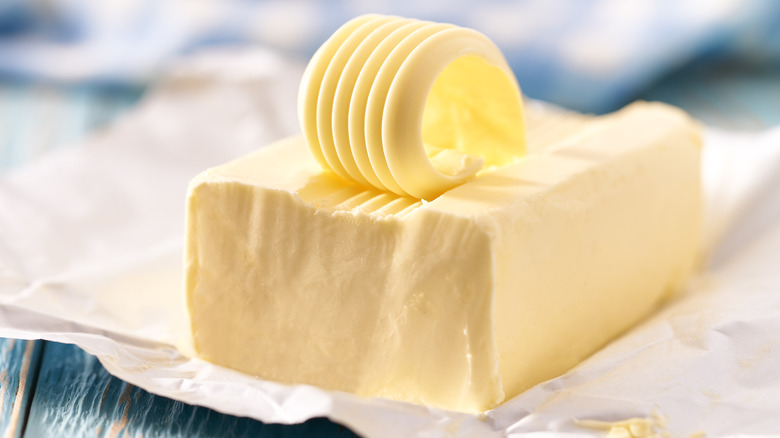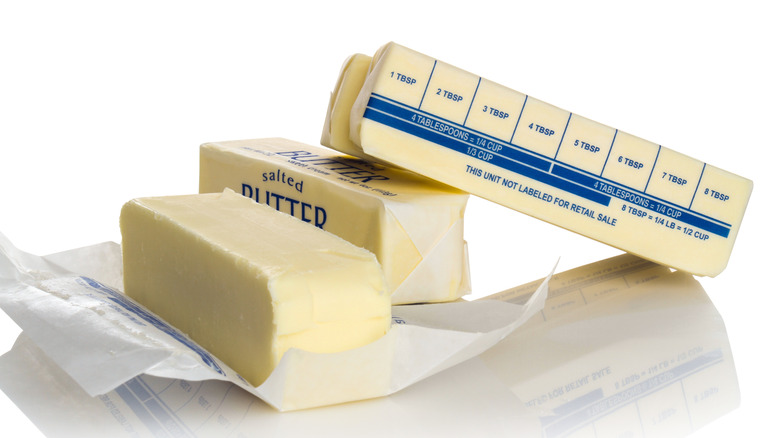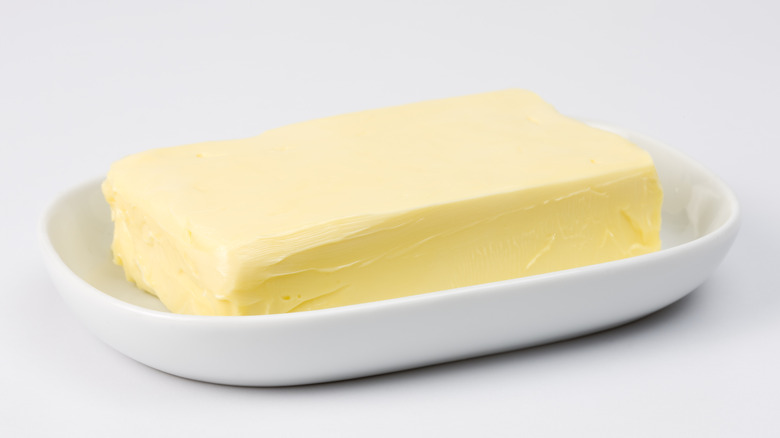2 Label Clues To Find The Best Butter At Your Grocery Store
From the perfect chocolate chip cookie to restaurant-quality steak, butter is one key component in countless recipes. Beyond that, it is among the most versatile ingredients and can transform ordinary dishes into extraordinary delights. It doesn't take a professional chef to appreciate the many applications of butter. Whether cooking an intricate French dish or simply looking to dress up your popcorn, butter will likely play a crucial role in your kitchen antics. That's why it pays to keep plenty of butter on hand — and high-quality butter at that. The large selection of different types of butter in your grocery store's dairy section may seem overwhelming, but there are ways to find the best choice.
Since it is frowned upon to open up the box and closely inspect a stick of butter in the supermarket aisle, you'll have to look at the label to determine if the butter you're buying is worth the price. Several indicators of a butter's quality are on the label, such as its ingredient list. Usually, a short list means better butter. Along with the ingredients, the most important clues you should look for on a butter's label are its butterfat content and information on how it was churned.
High butterfat indicates a richer taste
When you examine the packaging on a stick of butter, you'll often find a percentage labeled as butterfat content. The higher the butterfat content, the richer and more flavorful the butter tends to be. This figure typically is around 80% for American butter. In the United States, butter must have a butterfat content of at least 80%, or it will be considered a "spread" instead. European butter tends to have a higher butterfat content, up to 86%.
Butterfat plays a pivotal part in defining the texture and mouthfeel of the butter. A higher butterfat content results in a creamier and smoother texture, making it ideal for spreading on bread or incorporating into recipes where a velvety consistency is desired. On the other hand, lower butterfat content may lead to a firmer texture, which could be preferable in certain scenarios.
Moreover, butterfat is responsible for carrying and enhancing the flavors in butter. This is why European-style butter, with its higher butterfat content, often exhibits a more pronounced and complex flavor profile. In essence, the butterfat content on a stick of butter is a description of its richness, texture, and potential applications in the kitchen.
How butter was churned matters
While searching for the perfect butter, you should pay attention to the terms "slow churn" or "small batch" on the label. These terms may sound like marketing buzzwords, but they indicate specific production methods that can improve a butter's quality. Butter is typically made in a large churning machine that agitates huge quantities of fresh cream to separate the butter from the buttermilk. When made with such a large scale, fast method, the butter can develop air bubbles, which affect its taste and texture.
"Slow churn" refers to a deliberate churning process during butter production. This prolonged churning time typically produces butter with a creamier texture and a richer flavor profile. Similarly, "small batch" labels indicate that the butter is produced in smaller quantities, often with a heightened focus on craftsmanship and attention to detail. Small-batch production allows for greater control over the quality of ingredients and the overall process. Both slow churn and small batch labels suggest a departure from mass production in favor of a more artisanal approach.
These methods are often associated with a higher quality, emphasizing the nuanced characteristics of the butter. The resulting product tends to be distinct, with a flavor and texture that sets it apart from more commercially produced alternatives.


